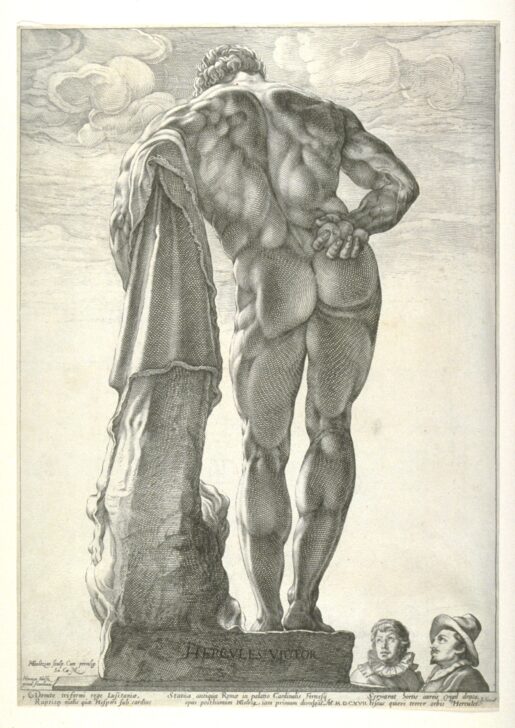The Farnese Hercules
Hendrick Goltzius

Description
March 28, 2009
Over the course of the sixteenth century a number of ancient sculptures were unearthed in Rome that had a profound and enduring impact upon artists, their patrons, and the public. One of the most famous among these antiquities was the Farnese Hercules, a colossal marble sculpture of the mythological hero leaning upon his club.
Goltzius, a virtuoso printmaker, studied the sculpture during a sojourn in Rome in 1591 and later strove to convey the experience of viewing the breathtaking statue in this engraving. The print, however, succeeded at more than merely recording the sculpture’s appearance as Jacob Bos had done in an engraving displayed in a drawer below. Using his unrivalled skill, Goltzius took the renowned sculpture as an inspiration and opportunity to display his mastery of his own chosen medium and create a reproductive print that was an artwork in itself.
Subject Matter:
This virtuosic engraving depicts the famous Farnese Hercules, a colossal ancient statue unearthed in Rome in the mid-sixteenth century and displayed there in the Farnese Palace. The statue represents Hercules resting upon his club, perhaps after he completed his eleventh labor of stealing the golden apples from the Hesperides, which he holds in his hand. The skin of the Nemean lion, which Hercules slew to complete his first labor, is draped over his club.
From the time of its discovery until the late eighteenth century the statue had a profound influence upon artists, many of whom made a pilgrimage to Rome to study the sculpture along with the city's other artistic glories. It was on such a sojourn in 1591 that the Dutch artist Hendrick Goltzius made careful drawings of the statue, which he translated into a tour-de-force engraving upon returning home to Haarlem.
Physical Description:
This impressively large engraving depicts the muscular back of a marble statue of a man. The figure leans upon a club draped with a lion skin and holds three apples in his right hand behind his back. Two men look up at the statue from the lower right corner of the print.
Usage Rights:
If you are interested in using an image for a publication, please visit https://umma.umich.edu/request-image/ for more information and to fill out the online Image Rights and Reproductions Request Form.